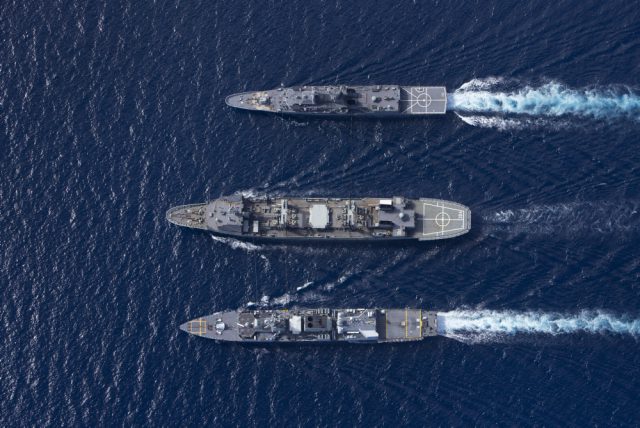
While Australia and Canada are similar in many ways, their approaches to defence policy are quite different, not least when it comes to their defence budgets. While Australia’s GDP is about 18% smaller than that of Canada, it spends considerably more on defence—US$24.0 billion this year, compared with Canada’s US$14.0 billion.
The Royal Australian Navy (RAN) and the Royal Canadian Navy (RCN) are recapitalising major parts of their fleets at around the same time, with the RAN’s SEA 5000 program and the RCN’s Canadian Surface Combatant (CSC) inching closer to decisions. It’s interesting to see how the two countries approach what at first glance looks like a similar defence problem, so we produced an analysis for the CDA Institute in Ottawa, which has published our findings in full in the latest issue of their On Track magazine.
Both countries are allies of the United States, and both have long and sparsely occupied coastlines, and large areas of ocean to surveil and secure. Both are commodity exporters and rely heavily on foreign sales for their prosperity.
But Canada has several important advantages compared to Australia. Canada and the US have the largest bilateral trade relationship in the world, which means Canada is less dependent on seaborne trade than Australia. And Canada’s contiguity with the continental US insulates it from geopolitical shifts in other regions of the world, and grants it an implicit American security guarantee. While Canada and the US are bound to defend each other through their membership in NATO, their geographic proximity means that the US would have an inherent interest in preventing foreign interference in Canada even without formal treaty commitments. Washington expects Canada to do its part, but as the more capable partner, the US takes the lead in continental defence—and it can’t opt out even if it judges that Ottawa isn’t pulling its weight.
Those essential differences play out in the military force structures of the two nations. One thing that’s immediately apparent is that the RAN is much more ‘balanced’ than the RCN—essentially it can do a little bit of everything, rather than focusing on one or two operational priorities. The RAN has a solid amphibious capability by virtue of its two Canberra-class LHDs and HMAS Choules. It also has a robust submarine capability in the six Collins-class boats. The core of its surface fleet currently comprises eleven frigates (three Adelaide-class and eight ANZAC-class) and will grow to twelve in future (three Hobart class DDGs and nine Future Frigates).
The RAN’s force structure reflects the fact that Australia is far away from its ANZUS ally, and has de-facto responsibility for security in its near region (as was evidenced by the small role played by the US in the INTERFET operation in East Timor). Australia needs a reasonable level of self-sufficiency to carry out that role. Having a ‘balanced’ fleet allows the RAN to respond to a variety of threats, from high-end warfighting to humanitarian assistance/disaster relief in the South Pacific. Australia also needs to be able to pull its weight as a US ally, hence the acquisition of Aegis destroyers and the emphasis on using an American combat system and weapons for its submarines.
The RCN, on the other hand, is much more specialised. Due to its implicit security guarantee that comes with the land border with the US, Canada doesn’t have to worry much about defending North America’s maritime environs. So the RCN has traditionally focused its warfighting capabilities further afield, mainly in Europe. And as part of the broad NATO alliance, Canada can opt to provide a high level of capability in a relatively narrow spectrum of activities. During the Cold War the RCN was a prominent contributor to NATO’s anti-submarine warfare (ASW) operations and its current force structure reflects that heritage. It currently operates 12 Halifax-class frigates optimised for ASW, as well as four Victoria-class diesel electric submarines that, among other duties, help NATO navies hone their ASW skills.
Australia is embarking on an ambitious program to double the size of its submarine arm from six to twelve, thus matching the number of major surface combatants. But the RCN’s submarine fleet is small compared to its surface fleet and there seems to be little appetite for an expansion of the RCN’s underwater capability. The RCN doesn’t field much in the way of amphibious capability, and has no specialist air defence vessels—two areas in which Australia has made a substantial investment.
The specialisation that Canada has been able to pursue has resulted in a Navy that is focused but limited in the scope of activities it can undertake. But it’s also substantially less expensive than Australia’s ‘balanced force’, thus allowing Canada to do defence on the (relative) cheap. That all reflects the difference between an implicit but unshakeable security guarantee and one that is contingent on the US deciding that it needs to be engaged an ocean away from its own shores.

